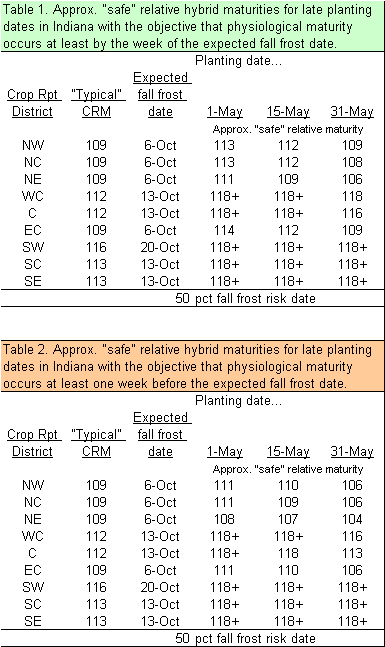26 Apr 2011
URL: http://www.kingcorn.org/news/articles.11/SafeHybridMaturities-0426.html

The Crop Reporting Districts are those defined by the National Ag.
Statistics Service, USDA, for Indiana.
The acronym “CRM” refers to
Comparative Relative Maturity as defined by Pioneer Hi-Bred.
"Safe" Hybrid Maturities for Delayed Corn Planting in Indiana
R.L. (Bob) Nielsen
Agronomy Dept., Purdue Univ.
West Lafayette, IN 47907-2054
Email address: rnielsen
at purdue.edu
![]() t seems early to begin fearmongering about the possible necessity of switching to earlier relative hybrid maturities, but the similarities of this planting season with other late planting years is making some farmers fidget a little as they impatiently wait for fields to dry out. One of the biggest agronomic concerns with severely delayed planting is the risk of the crop not reaching physiological maturity before a killing fall freeze and the yield losses that could result. An economic concern with delayed planting is the risk of high grain moistures at harvest and the resulting costs incurred by drying the grain or price discounts by buyers.
t seems early to begin fearmongering about the possible necessity of switching to earlier relative hybrid maturities, but the similarities of this planting season with other late planting years is making some farmers fidget a little as they impatiently wait for fields to dry out. One of the biggest agronomic concerns with severely delayed planting is the risk of the crop not reaching physiological maturity before a killing fall freeze and the yield losses that could result. An economic concern with delayed planting is the risk of high grain moistures at harvest and the resulting costs incurred by drying the grain or price discounts by buyers.
The tables that accompany this article list "safe" relative hybrid maturities for corn planted throughout the month of May based on their heat unit requirements (adjusted for planting date) and anticipated "normal" accumulation of heat units between planting and an average date (50% probability) of a killing fall freeze. Because GDD accumulations are generally less and "usual" fall frosts occur earlier in the northern and eastcentral areas of Indiana, delayed planting forces hybrid maturity changes earlier than other areas of the state. However, even for those areas of Indiana, serious departures from "typical" hybrid maturities need not be considered until later in May.
The maturities listed in Table 1 are those that should reach physiological maturity at least by the week when a killing fall freeze occurs, while Table 2 lists hybrid maturities that should mature at least one week PRIOR to a killing fall freeze. When making a decision to plant hybrid maturities that are unusually early for your area of the state, make the effort to identify hybrids with good disease resistance traits.
Recognize that while the hybrid maturities listed in either table should safely mature by their respective dates, severely delayed plantings will likely mature at a later time in the fall when further grain drying in the field typically occurs at a proverbial snail's pace. Thus, grain moisture at harvest for delayed plantings may be unacceptably high in terms of both the ease of harvest and the costs of artificially drying the grain.
Farmers can mitigate this aggravation somewhat by planting even earlier maturity hybrids, but recognize that there may not be as great of a difference in grain moisture content as you think. Typically, a one "day" difference in relative maturity rating equals 0.5 percentage point difference in grain moisture content at harvest (Nielsen, 2009). That means there will only be about 2 points difference between, say, a 106-day hybrid and a 110-day hybrid at harvest.
Related References
Nielsen, Bob. 2002 (rev). Estimating Yield and Dollar Returns From Corn Replanting. Purdue Univ. Cooperative Extension Service publication AY-264-W. Online at http://www.agry.purdue.edu/ext/pubs/AY-264-W.pdf. [URL accessed Apr 2011].
Nielsen, R.L. (Bob). 2009. Interpreting Corn Hybrid Maturity Ratings. Corny News Network, Purdue Univ. [online] http://www.kingcorn.org/news/timeless/HybridMaturity.html [URL accessed Apr 2011].
Nielsen, R.L. (Bob) and Peter Thomison. 2003. Delayed Planting & Hybrid Maturity Decisions. Purdue Univ. Cooperative Extension Publication AY-312-W. [On-line]. Available at http://www.agry.purdue.edu/ext/pubs/AY-312-W.pdf [URL accessed Apr 2011].
Nielsen, Robert L., Peter R. Thomison, Gregory A. Brown, Anthony L. Halter, Jason Wells, and Kirby L. Wuethrich. 2002. Delayed Planting Effects on Flowering and Grain Maturation of Dent Corn. Agron. J. 94:549-558.

